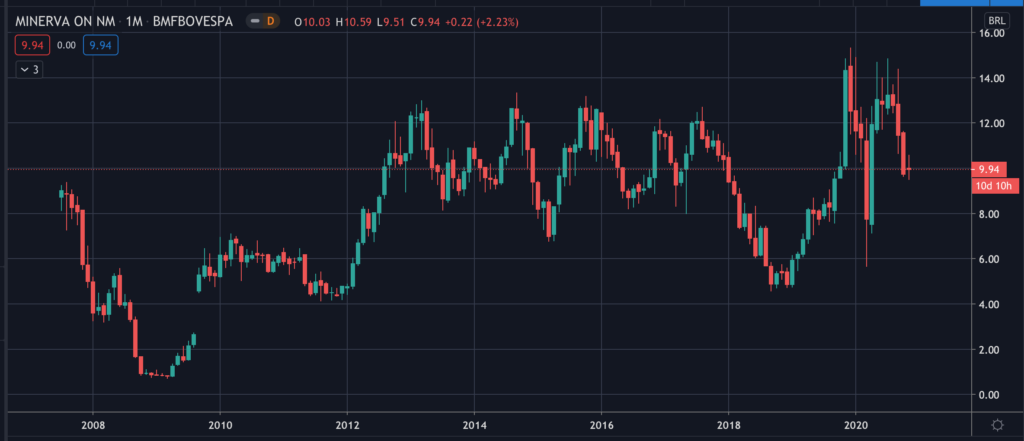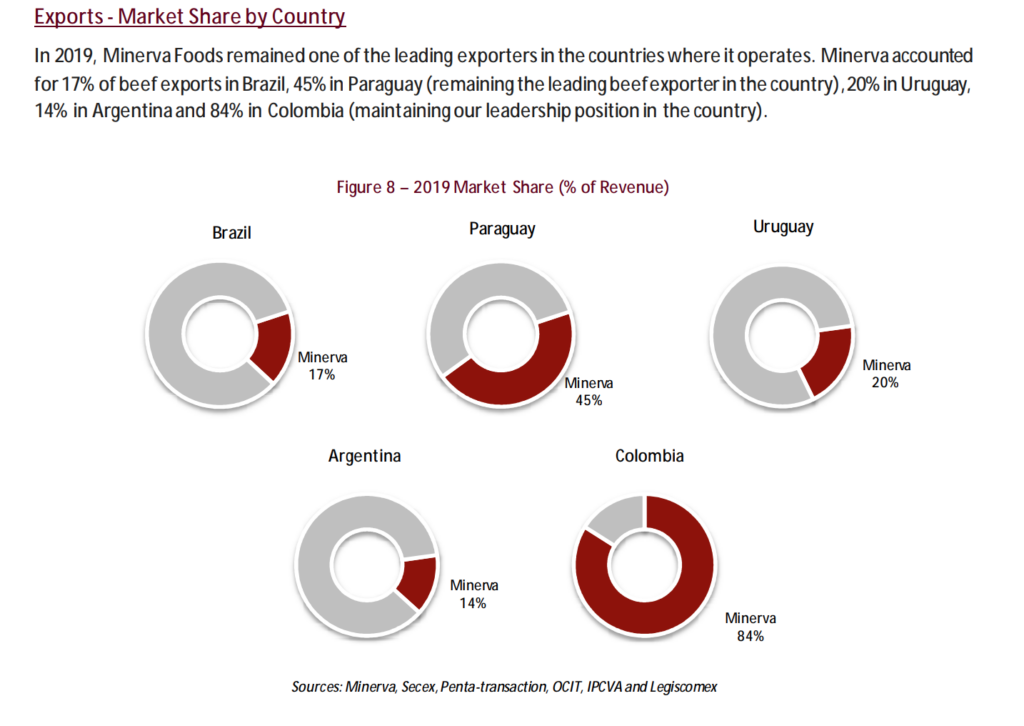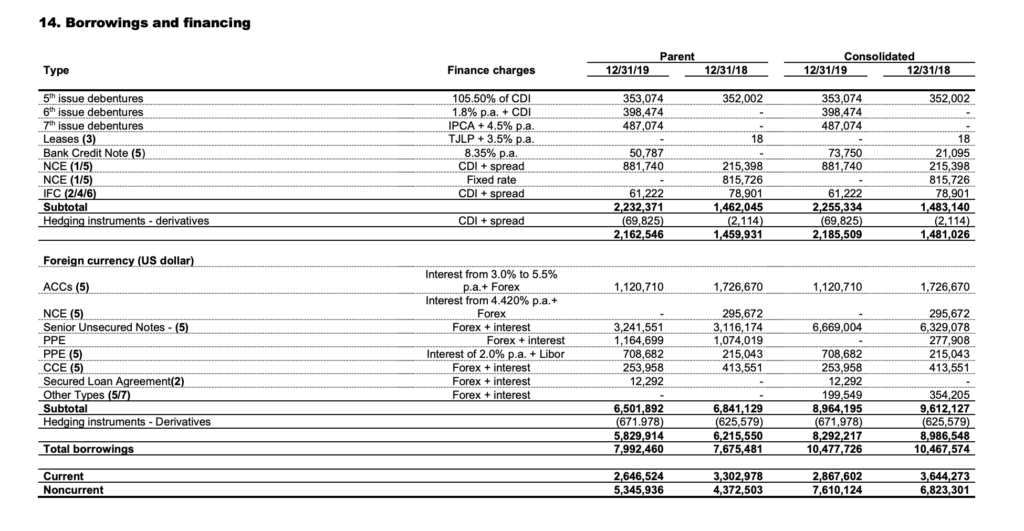Common Stock: Minerva Foods (BEEF3)
Current Market Price: R$ 9.94
Market Capitalization: R$ 5.5 billion
*All values in this article are expressed in Brazilian Reais (BRL) unless otherwise noted.
**The bulk of this analysis is based on the company’s most recent audited financial report, which can be found by following this link.

Minerva Foods Stock – Summary of the Company
Minerva Foods is a Brazilian food company focused on the production, distribution, and sale of beef products. They have 24 manufacturing facilities and 3 processing and have subsidiaries in Colombia, Chile, Uruguay, Argentina, and Paraguay. Their production capacity is over 26,000 head of cattle per day. They export their products to over 100 countries. Minerva was founded in 1957 and is headquartered in the state of Sao Paulo, Brazil.

Revenue and Cost Analysis
Minerva Foods had revenue of R$ 17.1 billion in 2019, an increase from R$ 16.2billion in 2018. Their COGS was R$ 13.8 billion in 2019, representing a gross margin of 19.2%, an improvement from 17.5% in 2018.
The company had a small profit of R$ 16.1 million, representing a profit margin of less than 1%. However this is a significant improvement compared to a net loss of R$ 1.3 billion in 2018.
Balance Sheet Analysis
Minerva Food has a decent but leveraged balance sheet. They have a sufficient liquidity position and a solid base of assets, however they have high liability levels, including debt.
It is worth noting that the company has a significant hedging book and uses derivative to hedge their US dollar exposure and the price of cattle. Investors should analyze these derivative instruments in detail before investing.
Minerva Foods – Debt Analysis
As of year-end 2019 Minerva has 10.7 billion in total debt outstanding, R$ 2.8 billion of which is classified as current. R$ 9 billion of this debt is denominated in US dollars, exposing the company to the negative effects of a depreciating Brazilian Real.

Minerva Foods Stock – Share Dynamics and Capital Structure
As of October 2020 Minerva Food has 548.4 million commons shares outstanding. Around 52% of the company’s shares are owned by holding companies, 44% are owned by smaller shareholders with a position of less than 5%, with the remaining 4% being owned by the company’s treasury.

Minerva Foods Stock – Dividends
The company did not pay a dividend based on 2019’s results.
Minerva Foods Stock – 2 Metrics to Consider
Debt to Equity Ratio
Total Liabilities/Total Share Holder Equity
R$ 13.5 billion / -R$ 281 million = – 48
A debt to equity ratio of negative 48 indicates that Minerva has accumulated losses and has significantly more liabilities than shareholder equity. This generally indicates the possibility of insolvency. However the company’s year over year operating results have improved, so there is reason to believe this metric may improve moving forward. Either way investors should carefully analyze the company’s liabilities before investing.
Working Capital Ratio
Current Assets/Current Liabilities
R$ 8.3 billion / R$ 5.6 billion = 1.5
A working capital ratio of 1.5 indicates a sufficient liquidity position. Minerva should not have problems meeting its near term obligations.
Brazilian Agriculture Market – Economic Factors and Competitive Landscape
Brazil is an agricultural powerhouse, it ranks 5th in the world in terms of arable land. Agriculture is a large and important industry for the Brazilian economy. Brazil is the world’s largest producer of oranges, sugarcane, and coffee. They also compete globally in the production of soy, meat, and corn. Brazils’ diverse geography allows it to produce a wide variety of crops.
Global agricultural is a highly competitive market subject to large swings in global commodity prices. Brazilian agricultural companies will have to compete fiercely on a global stage for exports. However, given the scale of the industry in Brazil, I believe it is reasonable to assume that there are many well run, investable agriculture companies in Brazil.
Minerva Foods Stock – Summary and Conclusions
Minerva Food is a large, global company focused entirely on its core business of beef. The company has significant market share in the countries where it operates, for example they accounted for 17% of all Brazilian beef exports in 2019. Minerva appears to be improving its operating results. Gross margins improved in 2019 and the company had a very small profit, compared to a significant loss in 2018. Their liquidity position is sufficient in the near term, however the company is over levered.
Debt levels are too high and a depreciating Brazilian Real is sure to have negatively impacted the company’s 2020 results, due to their large amount of US dollar denominated debt. I am optimistic about their long term prospects due their improving operating results. However based on their current financial position and valuation, I am not willing to invest in Minerva stock. I will leave the company at the top of my watchlist and revisit my decision based on their 2020 results. Investors can compare Minerva Food stock to other Brazilian beef companies, such as Marfrig.
Disclaimer
This is not investment advice. Nothing in this analysis should be construed as a recommendation to buy, sell, or otherwise take action related to the security discussed. If I own a position in the security discussed, I will clearly state it.
This is not intended to be a comprehensive analysis and you should not make an investment decision based solely on the information in this analysis. I hope this serves as a useful starting point for a more comprehensive analysis, and hopefully draws attention to aspects of the company that were overlooked or merit further investigation. This is by no means intended to be a complete analysis. Again, this is not investment advice, do your own research.